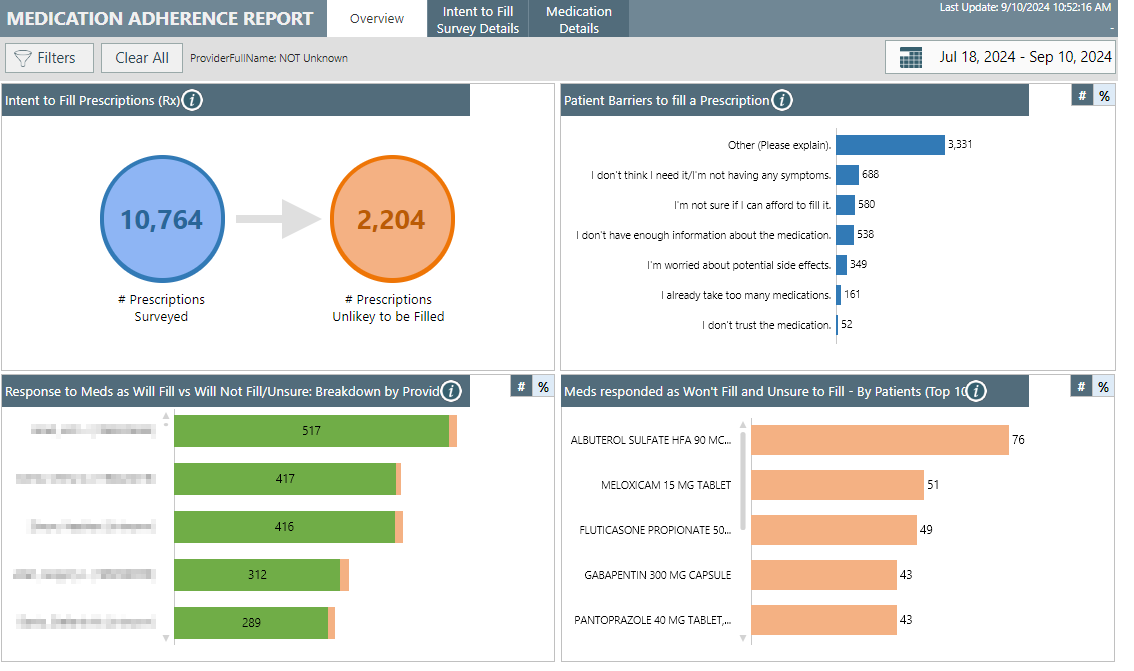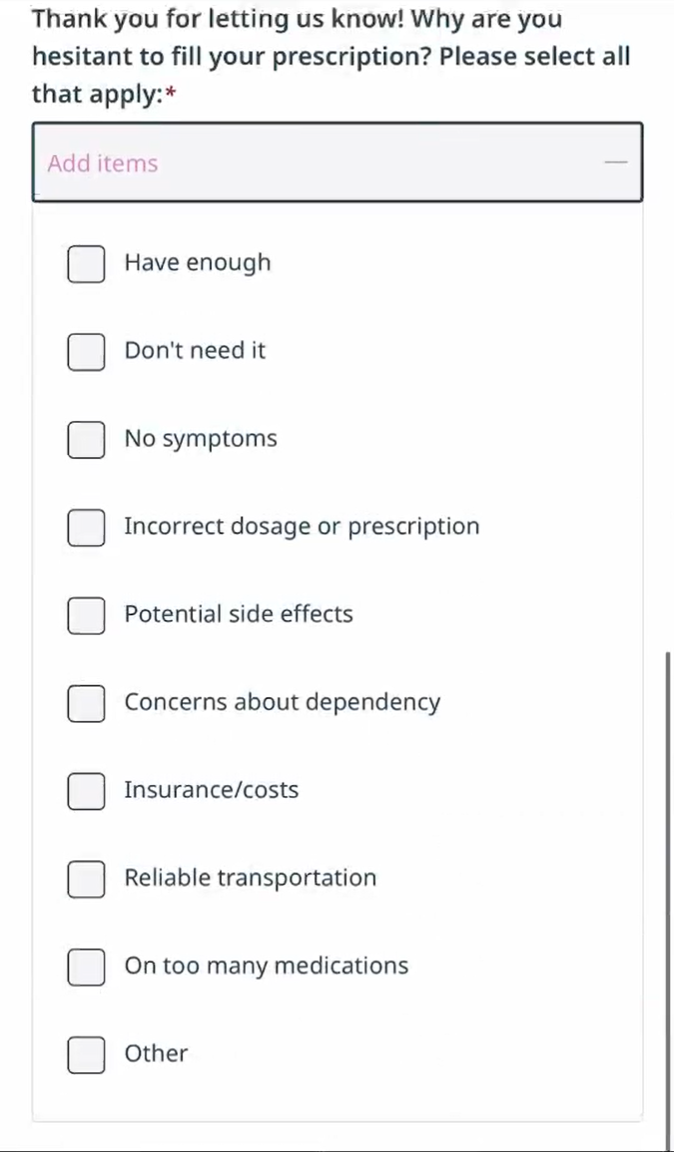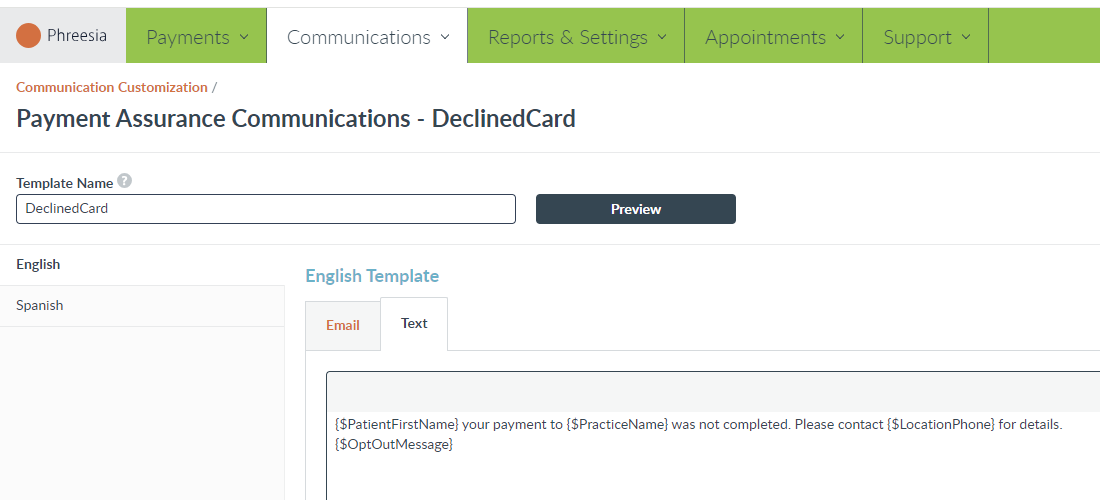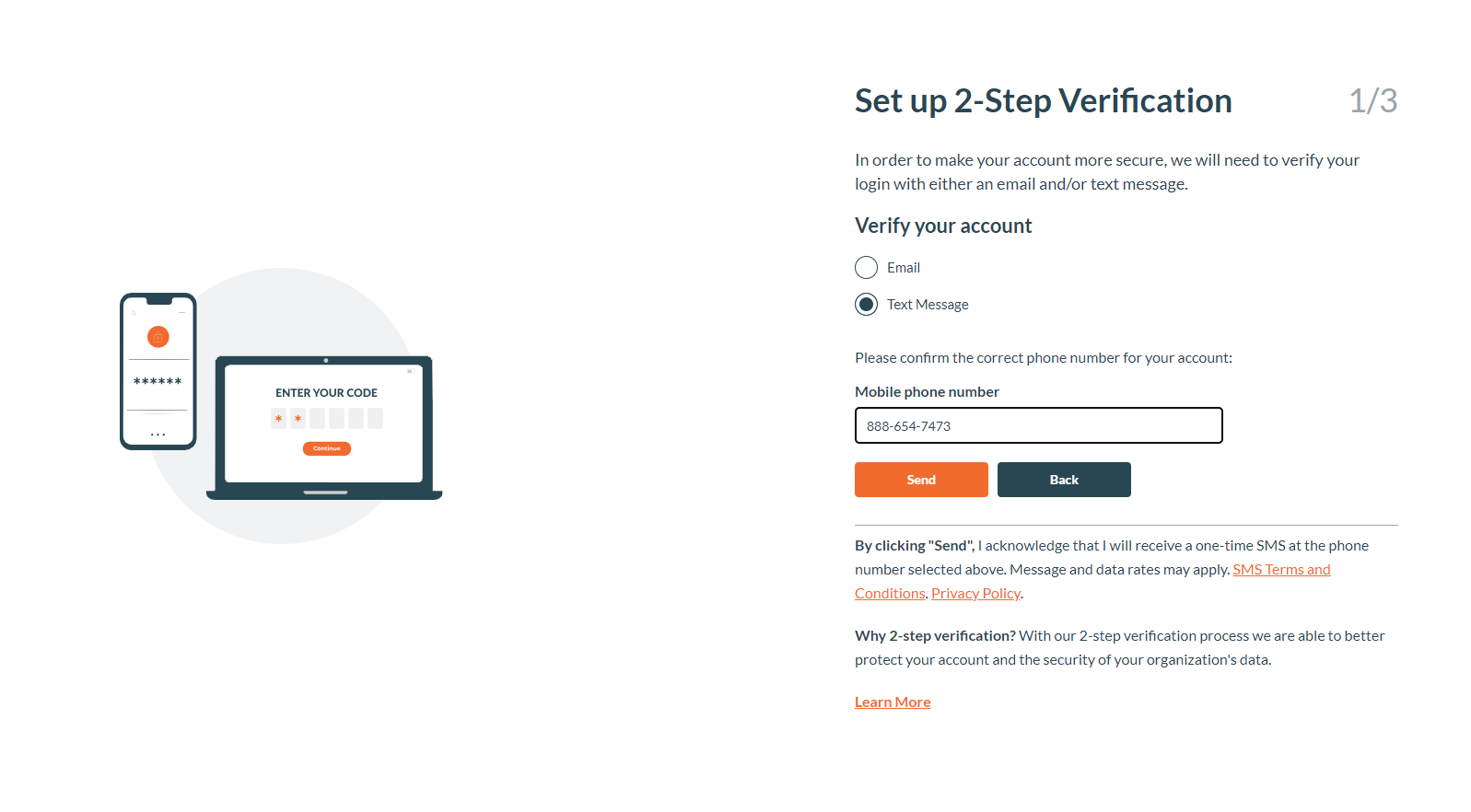- Summary
- Featured
- Appointments
- Payments
- Privacy and security
- Registration
- Standardized content
- Updates to the Patient Activation Measure® (PAM®) Suite
- Updates to the Mpox Intake and Outreach Suite
- New versions of PHR: Pediatric TB Exposure Risk
- New PHR: WellRx Questionnaire
- New PHR: Fagerström Test for Nicotine Dependence (FTND)
- New PHR: Self-Rated Level 1 Cross-Cutting Symptom Measure - Child
- New PHR: Scoliosis Research Society 22-Item Questionnaire (SRS-22r)
- New PHR: Pain Intensity, Enjoyment of Life, General Activity Scale (PEG-3)
Summary
Don’t have time to read the entire 24.11 Release Notes? We understand—you’re busy! Use the table of contents on the left to easily jump to different sections, if needed.
Featured
Analyze patient barriers to filling prescriptions
The Medication Adherence report now includes charts showing patients’ intent to fill and barriers to filling a prescription. (This information is captured through Medication Adherence survey workflow.) Plus, you can filter the report to view data by specific provider, by medication and by barrier.

Filtering the charts helps you:
- Quickly analyze patients’ barriers to filling prescriptions
- Compare differences between medications
- Compare differences between providers at your organization
- View a list of medications patients don’t plan to fill
Access the report in the “Analytics” tab of your Dashboard.
Not using Medication Adherence yet?
New options for prescription barriers in Medication Adherence report
We added more options that patients can select when indicating why they don’t plan to pick up a prescription in the Medication Adherence workflow.
The new options include:
- Have enough
- Incorrect dosage or prescription
- Concerns about dependency

We added these choices because patients often submit these reasons in free text. Free text responses can be difficult to analyze, so adding them as options will help you more easily identify actionable trends.
The new options will be automatically added to the Medication Adherence workflow upon release.
Reusable custom filters in Patient Bill Pay workflows
You can now create and save custom filters in the Patient Billing Manager to match your workflow needs.

Reusing custom filters makes it quicker and easier to set up the appropriate filters on a new bill review workflow and eliminates the risk of human error.
This feature will be automatically available upon release.
Appointments
‘Any First Available Provider’ option for self-scheduling in Oracle Millennium
We now allow patients to request the earliest available time slot when self-scheduling at an organization using Oracle Millennium 14.1. Allowing them to select the first available slot helps accelerate care and keep providers’ schedules full.
Previously, patients had to choose a specific provider to book an appointment.
This feature will be automatically available upon release.
Improved quality of voice functionality in Appointment Reminders
We addressed an error causing prerecorded voice messages to sometimes give a phone number as a quantity (i.e., spelling out the phone number 555-444-1234 as 5,554,441,234). That mistake could confuse patients if the voice message they received misread your organization’s phone number.
This fix will take place automatically upon release.
Payments
Customize Payment Assurance text messages
Communicate more clearly with patients by customizing the text messages they receive when an automatic payment fails. You can share the next steps specific to your payments process.
Payment Assurance already supported email customization—now, you can ensure consistency across channels.
This feature will be automatically available upon release.

Privacy and security
Display disclaimer for Two-Factor Authentication
We have improved upon our two-factor authentication (2FA) to clarify our Terms and Conditions and Privacy Policies. 2FA is an added security option to help you keep your organization’s data and your patients’ protected health information secure.
You’ll see this message going forward when setting up 2FA.

Registration
Improved access to patient notifications on the Mobile Dashboard
We’ve made it easier to see patient notifications on the Mobile Dashboard from desktop. You can now click the far left of the patient’s row on the Mobile Dashboard to see these icons, rather than clicking into the Patient Details slide-out.
This improvement will be automatically available upon release.

Standardized content
Updates to the Patient Activation Measure® (PAM®) Suite
We updated our PAM offerings to use gender-neutral pronouns per industry standard recommendations. We’ve also updated the introduction screen to make it more streamlined for patients to complete at an appropriate literacy level.
Clients who are currently using the default PHR: PAM-13 module will be updated with the latest introduction screen and latest assessment version on release.
For additional information and enablement instructions, please contact your Phreesia representative.
Updates to the Mpox Intake and Outreach Suite
We updated our Mpox intake and outreach modules to align with new recommendations from the World Health Organization (WHO) and Centers for Disease Control and Prevention (CDC).
We now offer version 2.0 for the following screening modules:
- PHR: Mpox Screener – Full
- PHR: Mpox Screener – Express
We also updated our Mpox Health Campaign templates and announcement.
- Health Campaigns
- PHR: Mpox awareness and basic education
- PHR: Mpox vaccine information and scheduling
- Announcement
- PHR: Mpox awareness and basic education
For additional information and enablement instructions, please contact your Phreesia representative.
New versions of PHR: Pediatric TB Exposure Risk
We added two new versions to our current PHR: Pediatric TB Exposure Risk module, versions C and D. These versions reflect a slight update to the time specified in question 5. The question now better aligns with certain state specific requirements and CDC recommendations.
- Version C: Since your last well visit/physical, has the patient or a household member traveled outside of the United States, Canada, Australia, New Zealand or Western Europe and spent more than one month with people who live in that country?
- Version D: Since your last well visit/physical, has the patient or a household member traveled outside of the United States, Canada, Australia, New Zealand or Western Europe and spent more than three months with people who live in that country?
You can choose which version to offer based on your patient population and their needs.
For additional information and enablement instructions, please contact your Phreesia representative.
New PHR: WellRx Questionnaire
We now offer the WellRx Questionnaire, a validated, 11-item social drivers of health (SDOH) module designed to be used at every patient visit. It asks patients to self-report their experiences with food insecurity, housing, utilities, income, employment, transportation, education, substance abuse, childcare, safety and abuse.
For additional information and enablement instructions, please contact your Phreesia representative.
New PHR: Fagerström Test for Nicotine Dependence (FTND)
We now offer the Fagerström Test for Nicotine Dependence (FTND), which assesses the intensity of physical addiction to nicotine. The test has six items that measure cigarette consumption, compulsion to use and dependence.
The FTND focuses on two areas of nicotine dependence: the patient’s urgency to return to a nicotine threshold after nighttime abstinence and the patient’s behavior to maintain that threshold during waking hours.
For additional information and enablement instructions, please contact your Phreesia representative.
New PHR: Self-Rated Level 1 Cross-Cutting Symptom Measure – Child
We now offer the Self-Rated Level 1 Cross-Cutting Symptom Measure – Child, a 25-question tool that assesses mental health domains in pediatric populations. These include depression, anger, irritability, mania, anxiety, somatic symptoms, inattention, suicidal ideation/attempt, psychosis, sleep disturbance, repetitive thoughts and behaviors, and substance use.
For additional information and enablement instructions, please contact your Phreesia representative.
New PHR: Scoliosis Research Society 22-Item Questionnaire (SRS-22r)
We now offer the Scoliosis Research Society 22-Item Questionnaire (SRS-22r), a validated questionnaire helping pediatric organizations survey and track patient-reported function, pain, self-image, mental health and satisfaction with management related to scoliosis.
For additional information and enablement instructions, please contact your Phreesia representative.
New PHR: Pain Intensity, Enjoyment of Life, General Activity Scale (PEG-3)
We now offer the Pain Intensity, Enjoyment of Life, General Activity Scale (PEG-3). Providers can use the PEG-3 to assess pain interference in patients’ daily life and can use it to guide personalized treatment plans improving their quality of life.
The tool has been recently updated to improve its utility for diverse patient populations, ensuring more accurate pain assessments and tailored interventions.
For additional information and enablement instructions, please contact your Phreesia representative.
